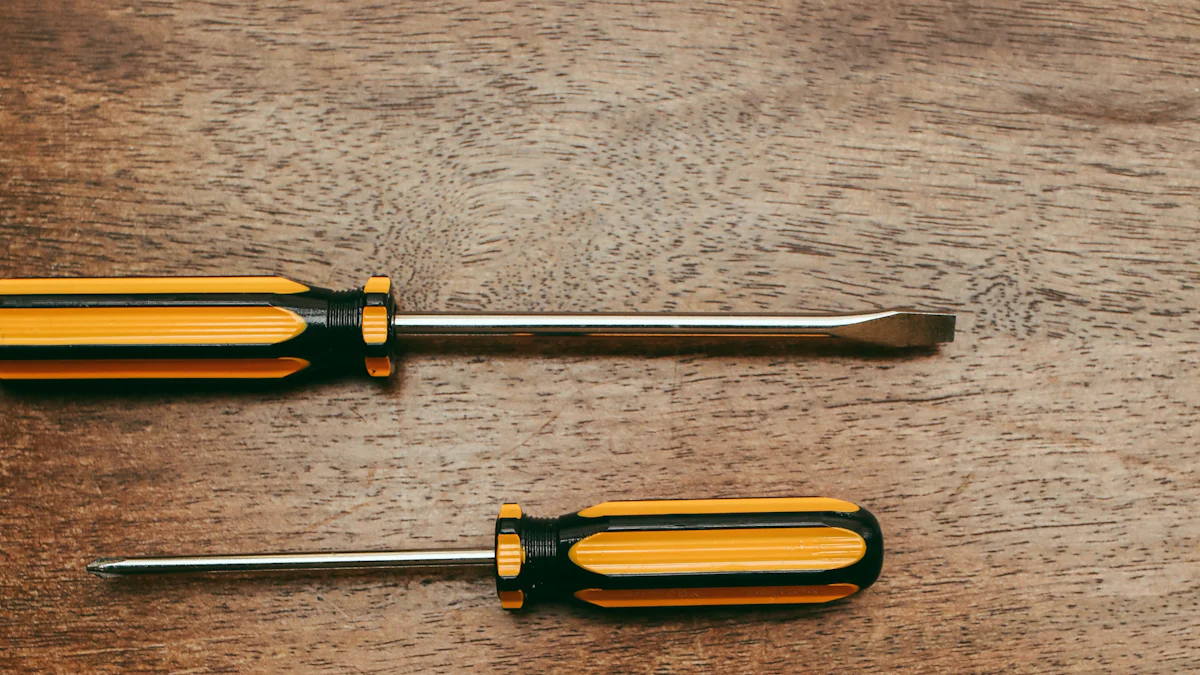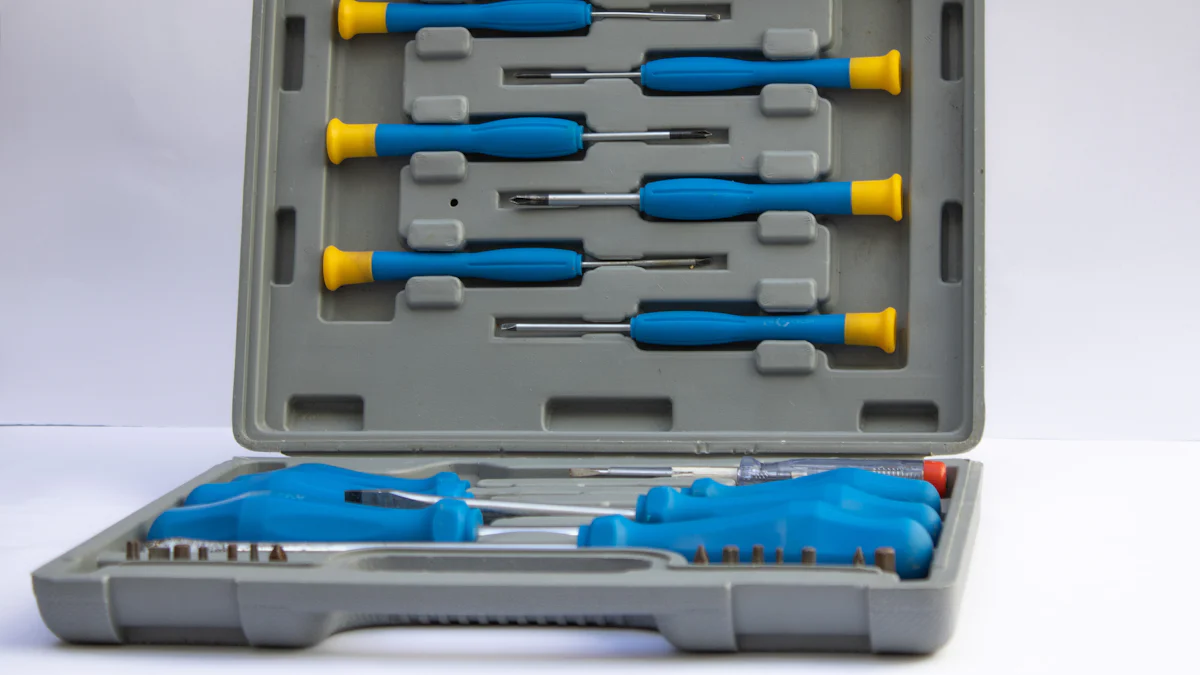
Screwdrivers play a crucial role in various applications, from household repairs to industrial tasks. Despite their widespread use, many people confuse Pozidriv and Phillips screwdrivers. This confusion often leads to improper tool usage and potential screw damage. Understanding the differences between these two types of screwdrivers, including the specific design and functionality of a Pozidriv screwdriver, can help users choose the right tool for the job and avoid common mistakes.
Historical Context
Origins of Phillips Screwdrivers
Invention and Early Use
John Thompson applied for a patent in 1932 for a new type of screw. Thompson later sold his design to Henry Phillips. Phillips formed a new company and improved the design. The Phillips screwdriver featured a cross-shaped head that held screws tightly while being turned. This design allowed the driver to slip out once the screw was firmly in place. This innovation significantly improved productivity in various industries.
Popularity and Adoption in Industry
The Phillips screwdriver gained swift popularity in industrial settings. Industries like automotive manufacturing and aerospace adopted Phillips screws due to their efficiency. Consumers and DIY enthusiasts also embraced the Phillips screwdriver. The design reduced the likelihood of damaging screws during installation. The Phillips drive system became the standard in numerous industries.
Origins of Pozidriv Screwdrivers
Development and Purpose
The Pozidriv screwdriver emerged as an improved variation on the Phillips design. GKN Screws and Fasteners created the Pozidriv design after the Phillips head patent expired. The Pozidriv screwdriver featured a unique cross-like design with four additional points. This design ensured more positive tool engagement, resulting in less cam-out. The Pozidriv screwdriver allowed the application of higher torque without increasing the likelihood of cam-out.
Adoption and Use in Europe
The Pozidriv screwdriver saw widespread adoption in Europe. The design’s increased torque capacity made it suitable for high-stress applications. European manufacturers favored the Pozidriv screwdriver for its improved grip and reduced cam-out. The Pozidriv screwdriver became a common tool in various industries across Europe. The ISO standard designated Pozidriv screwdrivers as PZ, making them easy to identify.
Design and Features

Phillips Screwdrivers
Head Design
The head design of Phillips screwdrivers features a simple cross shape. This design allows the screwdriver to fit snugly into the screw head. The cross shape helps guide the screwdriver into the screw, making it easier to align. However, the Phillips design tends to cam out under high torque. This cam-out feature prevents over-tightening but can lead to material damage.
Screwdriver Tip Design
Phillips screwdrivers have a tapered tip. The tapering helps the screwdriver fit into the screw head more easily. The tip design also contributes to the cam-out effect. When too much torque is applied, the screwdriver slips out of the screw head. This slipping action reduces the risk of damaging the screw or the material being fastened.
Pozidriv Screwdrivers
Head Design
The head design of Pozidriv screwdrivers includes a cross-like shape similar to Phillips but with additional lines between the arms. These extra lines provide a greater driving surface. The increased surface area allows for more torque without cam-out. Pozidriv screws also have parallel-sided arms, which further enhance grip and reduce wear.
Screwdriver Tip Design
Pozidriv screwdrivers feature a blunt tip with parallel flanks. The blunt tip ensures a more secure fit in the screw head. The parallel flanks provide a larger contact area, reducing the likelihood of slippage. Pozidriv screwdrivers also include smaller ribs at a 45-degree angle to the main slots. These ribs improve torque transfer and minimize cam-out.
Functional Differences

Torque and Cam-Out
Phillips Screwdrivers
Phillips screwdrivers feature a cruciform-shaped tip with angled flanks. This design enables greater torque application but also causes an axial force. This force pushes the driver out of the screw during operation, known as cam-out. The cam-out effect prevents over-tightening but can damage the material. Phillips screwdrivers are suitable for applications requiring moderate torque. However, the tendency to cam out limits their effectiveness in high-torque scenarios.
Pozidriv Screwdrivers
Pozidriv screwdrivers offer improved torque transmission compared to Phillips screwdrivers. The design includes additional lines between the arms, providing a larger driving surface. This feature prevents cam-out even under high torque. Pozidriv screwdrivers allow for higher torque application without damaging the screw head. The blunt tip and parallel flanks ensure a secure fit, reducing slippage. Pozidriv drivers excel in high-stress applications where precision and torque are critical.
Applications and Suitability
Common Uses for Phillips
Phillips screwdrivers are common in various industries. Automotive manufacturing frequently uses Phillips screws due to their efficiency. Aerospace industries also favor Phillips screws for their ease of use. DIY enthusiasts and consumers often choose Phillips screwdrivers for household repairs. The design reduces the likelihood of damaging screws during installation. Phillips screwdrivers are ideal for tasks requiring moderate torque and quick assembly.
Common Uses for Pozidriv
Pozidriv screwdrivers are prevalent in European manufacturing. Industries requiring high torque and precision prefer Pozidriv screws. The design’s increased torque capacity suits high-stress applications. European manufacturers favor Pozidriv screwdrivers for their improved grip and reduced cam-out. Pozidriv screwdrivers are common in furniture assembly, electronics, and heavy machinery. The ISO standard designation of PZ makes Pozidriv tools easy to identify and use.
Practical Advice and Recommendations
Choosing the Right Screwdriver
Factors to Consider
Selecting the correct screwdriver involves several key factors. First, identify the screw type. Pozidriv screws have additional lines between the arms, while Phillips screws feature a simple cross design. The application also matters. High-torque tasks benefit from Pozidriv screwdrivers due to their enhanced torque capacity. Phillips screwdrivers suit moderate torque applications.
Material compatibility is another consideration. Pozidriv screws offer better grip and reduced cam-out, making them ideal for high-stress materials. Phillips screws work well with softer materials where over-tightening is a concern. Tool availability plays a role. Specialized Pozidriv screwdrivers may not be as readily available as Phillips screwdrivers.
Specific Scenarios
Different scenarios require different screwdrivers. For automotive repairs, Phillips screwdrivers often suffice due to their widespread use in the industry. Furniture assembly benefits from Pozidriv screwdrivers, which provide better torque and grip. Electronics repair frequently uses Pozidriv screws for precision and reduced cam-out.
In household repairs, consider the screw type and material. A Phillips screwdriver works well for general tasks involving wood or plastic. For metal or high-stress applications, a Pozidriv screwdriver offers better performance. Always match the screwdriver to the screw type to avoid damage and ensure efficiency.
Maintenance and Care
Proper Use
Proper use of screwdrivers extends their lifespan and ensures safety. Always match the screwdriver to the screw type. Using a Phillips screwdriver on a Pozidriv screw can cause slippage and damage. Apply steady pressure when turning the screwdriver. Avoid excessive force that could strip the screw head.
Maintain a firm grip on the handle to prevent slipping. Use the correct size screwdriver for the screw. A mismatched size increases the risk of cam-out and damage. Regularly inspect screwdrivers for wear and tear. Replace worn tips to maintain efficiency and safety.
Storage and Handling
Proper storage and handling of screwdrivers prevent damage and extend their lifespan. Store screwdrivers in a dry, cool place to avoid rust. Use a tool organizer to keep screwdrivers sorted by type and size. This organization makes it easier to find the right tool quickly.
Avoid dropping screwdrivers, which can damage the tips and handles. Clean screwdrivers after use to remove debris and moisture. Wipe the tips with a cloth to prevent rust. Regular maintenance ensures that screwdrivers remain in good condition and ready for use.
Testimonial: “I have been using a handheld Stanley No.1 Pozidriv screwdriver on various size Phillips head screws for years now and found that it works very well, in fact better and tighter than a Phillips screwdriver in some cases.”
Proper care and selection of screwdrivers enhance their performance and longevity. By considering the factors outlined above, users can choose the right tool for any task and maintain it effectively.
Pozidriv and Phillips screwdrivers differ significantly in design and function. Pozidriv screwdrivers feature additional points for increased torque and reduced cam-out. Phillips screwdrivers have a simpler cross design, which often leads to cam-out under high torque.
Choosing the right tool for the job ensures efficiency and prevents damage. Pozidriv screwdrivers excel in high-torque applications, while Phillips screwdrivers suit moderate torque tasks.
Applying this knowledge in practical scenarios enhances productivity and tool longevity. Proper tool selection simplifies tasks and reduces operator fatigue.
